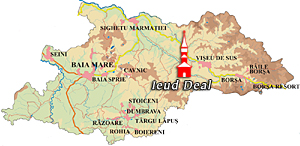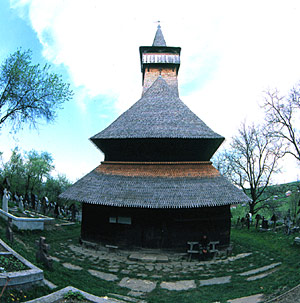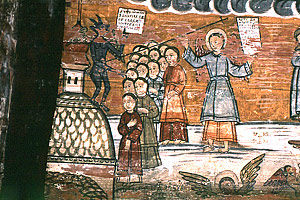Ieud Deal Church

Year built: second half of the 17th century
Location: Ieud Deal
Summary: For a long time it was thought that the present church is that more than 600 year-old edifice, which made it the most famous church in region. It is now known that marauding Tatars set the initial church on fire in the 17th century, and it was totally destroyed. Two 16th century books found in the present church are a proof of the existence of an older church in this place.

The well-preserved architecture, repaired and slightly modified during the 18th century, together with the interior paintings that were made at the end of the same century, meant that the church was included on the UNESCO World Heritage List.
The roof of the main body of the church has large double eaves, while the slightly lower roof of the chancel has only one set of eaves. Above the pronaos rises the solid square tower with a square balcony and a tall conical spire. Eight pillars and eight arches support the spire. The church was quite big for the 17th century, which indicates that the parish was quite large.
The church stands on a small hill on the opposite side of the river from the larger church of Ieud Ses.

The interior paintings of the church form one of the best-preserved entities of post-Byzantine mural painting in Maramureş. The paintings were made on pieces of textile that were treated with a preparatory layer of limewash and were then stuck to the wooden logs. The iconographic programme is particularly rich and impressive. The scenes are arranged in registers and each painting is related to the neighbouring ones. Not one corner of the church has been left unpainted. The inscriptions are in Romanian written with Cyrillic letters.
Alexandru Ponehalschi, a famous church and icon painter who created an artistic school in Maramureş, painted the church in 1782. He was deeply rooted in the traditions of the Byzantine art, combining the spontaneity of folk art with elements of western baroque. Out of these seemingly conflicting influences Ponehalschi managed to create his own style, and the murals of Ieud Deal are generally considered the apex of his career.
The interior paintings of the church form one of the best-preserved entities of post-Byzantine mural painting in Maramureş. The paintings were made on pieces of textile that were treated with a preparatory layer of limewash and were then stuck to the wooden logs. The iconographic programme is particularly rich and impressive. The scenes are arranged in registers and each painting is related to the neighbouring ones.



